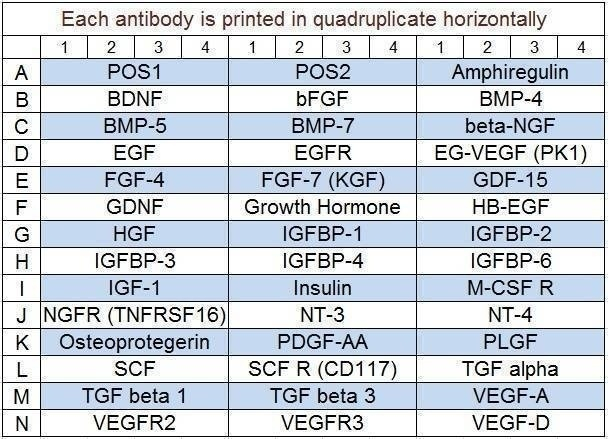Quantibody® Human Growth Factor Array 1 Kit. Detects 40 Human Growth Factors. Suitable for all liquid sample types.
Product Description
Specifications
| Size | 8 Sample Kit, 22 Sample Kit, 50 Sample Kit |
|---|---|
| Species | Human |
| Quantitative/Semi-Quantitative | Quantitative |
| Number of Targets Detected | 40 |
| Compatible Sample Types | Cell Culture Supernatants, Plasma, Serum, Tissue Lysates, Other Body Fluids, Cell Lysates |
| Solid Support | Glass Slide |
| Method Of Detection | Fluorescence Laser Scanner |
| Design Principle | Sandwich-based |
| Estimated Lead Time | 1-2 business days |
| Shipping Type | Blue ice |
| Storage | -20°C |

Amazon Gift Cards!
$5 Amazon gift card in every kit box purchased.
| Scroll over each target protein for more information | ||||
|---|---|---|---|---|
Amphiregulin
| BDNF
| bFGF
| BMP-4
| BMP-5
|
BMP-7
| beta-NGF
| EGF
| EGFR
| EG-VEGF (PK1)
|
FGF-4
| FGF-7 (KGF)
| GDF-15
| GDNF
| Growth Hormone
|
HB-EGF
| HGF
| IGFBP-1
| IGFBP-2
| IGFBP-3
|
IGFBP-4
| IGFBP-6
| IGF-1
| Insulin
| M-CSF R
|
NGFR (TNFRSF16)
| NT-3
| NT-4
| Osteoprotegerin (TNFRSF11B)
| PDGF-AA
|
PLGF
| SCF
| SCF R (CD117/c-kit)
| TGF alpha
| TGF beta 1
|
TGF beta 3
| VEGF-A
| VEGFR2
| VEGFR3
| VEGF-D
|
Application Notes
- Human Growth Factor Array Q1 Slide(s)
- Blocking Buffer
- Wash Buffer 1
- Wash Buffer 2
- Lyophilized Standard Mix
- Biotinylated Detection Antibody Cocktail
- Streptavidin-Conjugated Fluor
- Slide Washer/Dryer
- Adhesive Plastic Strips
- Manual
- Distilled or deionized water
- Small plastic boxes or containers
- Pipettors, pipette tips and other common lab consumables
- Orbital shaker or oscillating rocker
- Aluminum foil
- Gene microarray scanner or similar laser fluorescence scanner
View Compatible Laser Scanners
Don't have a compatible scanner? RayBiotech now offers FREE scanning service for all RayBio glass slide antibody arrays! Learn More
- Dry the glass slide
- Prepare Standards
- Block array surface
- Incubate with Samples and Standards
- Incubate with Biotinylated Detection Antibody Cocktail
- Incubate with Streptavidin-Conjugated Fluor
- Disassemble the glass slide
- Scan with a gene microarray laser scanner
- Perform densitometry and analysis
Storage/Stability
Skardal A., Devarasetty M., Kang H., et al. A hydrogel bioink toolkit for mimicking native tissue biochemical and mechanical properties in bioprinted tissue constructs. Acta Biomater. 2015 Oct;25:24-34. doi: 10.1016/j.actbio.2015.07.030.
Velez G., Bassuk A., Colgan D., et al. Therapeutic drug repositioning using personalized proteomics of liquid biopsies. JCI Insight. 2017 Dec 21;2(24). pii: 97818. doi: 10.1172/jci.insight.97818.
Skardal A., Mack D., Kapetanovic E., et al. Bioprinted amniotic fluid-derived stem cells accelerate healing of large skin wounds. Stem Cells Translational Medicine. 2012;1(11):792-802. doi: 10.5966/sctm.2012-0088.
Velez G., Roybal C., Colgan D., et al. Precision Medicine: Personalized Proteomics for the Diagnosis and Treatment of Idiopathic Inflammatory Disease. JAMA Ophthalmol. 2016 Apr;134(4):444-8. doi: 10.1001/jamaophthalmol.2015.5934.
Izrael M., Slutsky SG., Admoni T., et al. Safety and efficacy of human embryonic stem cell-derived astrocytes following intrathecal transplantation in SOD1G93A and NSG animal models. Stem Cell Res Ther. 2018 Jun 6;9(1):152. doi: 10.1186/s13287-018-0890-5.
Yang B., Deng Q., Zhang W., et al. Exposure to Polycyclic Aromatic Hydrocarbons, Plasma Cytokines, and Heart Rate Variability. Sci Rep. 2016 Jan 13;6:19272. doi: 10.1038/srep19272.
Reategui E., Fatemeh J., Khankhel A., et al. Microscale arrays for the profiling of start and stop signals coordinating human-neutrophil swarming. Nature Biomedical Engineering 1, Article number: 0094 (2017) doi:10.1038/s41551-017-0094
Leung GP., Feng T., Sigoillot FD., et al. Hyperactivation of MAPK Signaling Is Deleterious to RAS/RAF-mutant Melanoma. Mol Cancer Res. 2018 Sep 10. doi: 10.1158/1541-7786.MCR-18-0327
Panchaprateep, R., W. Korkij, and P. Asawanonda. "Brain?derived nerve factor and neurotrophins in androgenetic alopecia." British Journal of Dermatology 165.5 (2011): 997-1002.
Ciavarella S., Caselli A., Tamma A., et al. A peculiar molecular profile of umbilical cord-mesenchymal stromal cells drives their inhibitory effects on multiple myeloma cell growth and tumor progression. Stem Cells Dev. 2015 Jun 15;24(12):1457-70. doi: 10.1089/scd.2014.0254.
-
Human factor array Q1Easy to use with reproducible results. Plan to use it again.
from USC,
on
Human Growth Factor Array Q1Very easy to use. Sample processing is straight forward and allows multiple sample processing at the same time. I'd recommend this product.from Gateway Institute for Brain Research,
on
Great product.from Surgenex LLC,
on
Great productI really like the Quantibody Arrays. The data is consistent and reproducible. Important to strictly follow protocol, but very straightforward. Plan on using again.from University of California Davis,
on
Write Your Own Review

